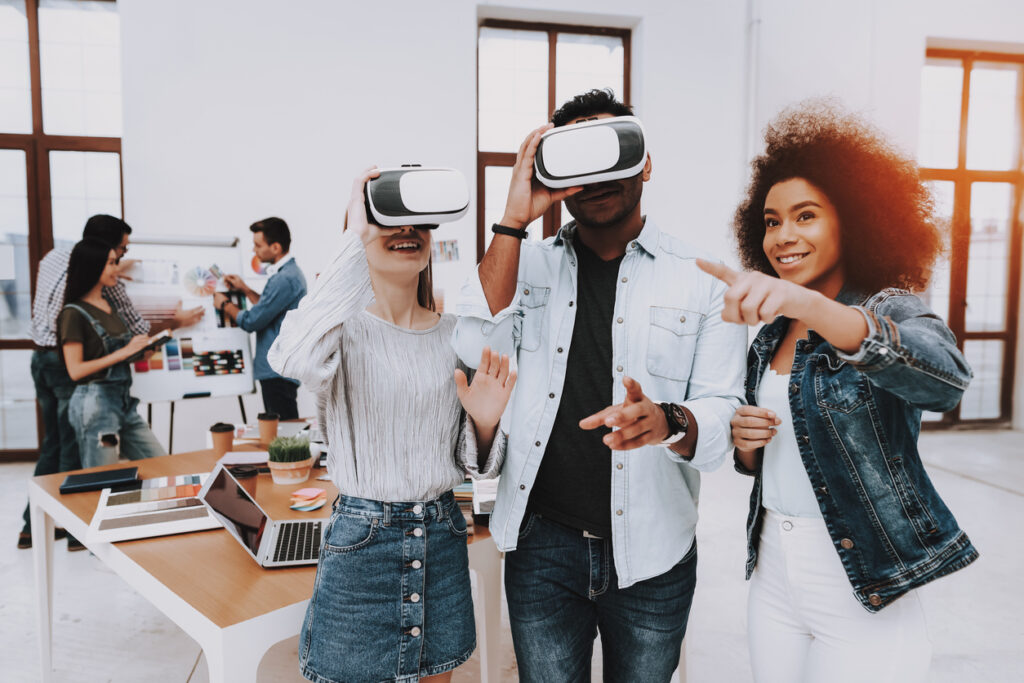Effective corporate training is becoming ever more critical as organisations adapt to the changing world of work and face the risk of a global talent shortage.
Training expenditures for large and mid-size companies are on the rise, pointing to the recognition of the need for continuous learning and the modernisation of training programmes.
Businesses are racing to ready themselves for new ways of working and the growing need to reskill, upskill and regenerate their workforces as working lives continue to extend.
Compounding the issue is the ongoing productivity dilemma.
The latest data from the Office of National Statistics stated that workplace productivity fell 0.2% in the first quarter of 2019 when compared with Q1 of 2018. It is clearly time for a learning and development revolution.
Virtual reality (VR) training might be just the answer companies are searching for.
With its roots in gaming, VR boasts the ability to secure high engagement levels.
When transferred to the L&D space this holds the promise of vastly improving the absorption and retention of information.
The truly industry-changing power, however, lies in the technology’s ability to capture a wealth of actionable data on overall training programmes and the trainees themselves.
Continuous improvement
Organisations can capture data on everything that happens in the VR training platform, building a rich and unique picture.
This can help to unearth the diamonds that exist within a business, and the rubble that gets in the way of optimum efficiency, consistency and safety during real-life processes.
Enterprise VR training can track a participant’s full experience, following the way they perform specific tasks as well as the conversations they’re having within the simulation with a trainer or other trainees.
As new features are added to VR platforms, the opportunities become even more exciting – data capture could soon include eye-tracking and biometric data.
A training report might show individual checkpoints achieved, important cues missed or mistakes made, and time to completion, among other valuable insights.
This nuanced and specific data holds the power to dramatically improve an employee’s development.
Employers can generate instant and unbiased training results straight after employees have completed a simulation, providing a level of consistent and benchmarkable information that cannot be gathered using familiar methods like PowerPoint presentations and multiple-choice quizzes.
Employees are able to repeat the identical training module on a number of occasions and clearly see the gains they are making in terms of efficiency and competency. This ultimately leads to workers who are more engaged, confident and capable.
Informed decisions
This data captured in aggregate holds immense value for companies.
Business leaders are able to track progress, measure outcomes and tailor future training programmes all using information captured in their training modules, giving them a clear steer on where improvement is needed.
This makes learning and development so much more than just a part of a company’s HR processes: it’s not just training for the individual, but the company as a whole.
The virtual reality training experience is bringing a new lease of life into the world of L&D.
For example, comprehensive data from all employees who have been through a training programme can help employers to assess the overall performance of their workforce and how well processes are being understood and followed.
Recordings of training sessions can also be used to meet requirements of auditors and regulators, indisputably showing that training has been completed and to the necessary standard.
Data from the VR platform can also help companies assess the value and effectiveness of their training, comparing performance over time and providing measurable outcomes and ROI.
As new features are added to VR platforms, the opportunities become even more exciting – data capture could soon include eye-tracking and biometric data.
Thinking ahead
Workplace training is long overdue a shake-up, with many traditional training methods unengaging for trainees and ineffective for employers.
The virtual reality training experience is changing this, bringing a new lease of life into the world of L&D.
Unsurprisingly, staff generally respond positively to a more engaging and immersive form of training.
This will be increasingly important as we move to upskill and reskill a large swathe of our current workforce.
Achieving the buy-in of employees for continued education will be critical in efforts to introduce new company processes, increase efficiency through greater understanding and push businesses into their next stage of growth.
With rich, continuous data comes a higher level of understanding and knowledge.
It can help leaders make wiser, fact-based decisions, while no longer having to rely entirely on guesswork, clipboard assessments and lengthy presentations.
Enterprise VR training does the job for you by collecting, quantifying and presenting the data that will help to power your organisation in the right direction.
Interested in this topic? Read Virtual worlds are teaching better lessons.
Effective corporate training is becoming ever more critical as organisations adapt to the changing world of work and face the risk of a global talent shortage.
Training expenditures for large and mid-size companies are on the rise, pointing to the recognition of the need for continuous learning and the modernisation of training programmes.
Businesses are racing to ready themselves for new ways of working and the growing need to reskill, upskill and regenerate their workforces as working lives continue to extend.
Compounding the issue is the ongoing productivity dilemma.
The latest data from the Office of National Statistics stated that workplace productivity fell 0.2% in the first quarter of 2019 when compared with Q1 of 2018. It is clearly time for a learning and development revolution.
Virtual reality (VR) training might be just the answer companies are searching for.
With its roots in gaming, VR boasts the ability to secure high engagement levels.
When transferred to the L&D space this holds the promise of vastly improving the absorption and retention of information.
The truly industry-changing power, however, lies in the technology’s ability to capture a wealth of actionable data on overall training programmes and the trainees themselves.
Continuous improvement
Organisations can capture data on everything that happens in the VR training platform, building a rich and unique picture.
This can help to unearth the diamonds that exist within a business, and the rubble that gets in the way of optimum efficiency, consistency and safety during real-life processes.
Enterprise VR training can track a participant’s full experience, following the way they perform specific tasks as well as the conversations they’re having within the simulation with a trainer or other trainees.
As new features are added to VR platforms, the opportunities become even more exciting - data capture could soon include eye-tracking and biometric data.
A training report might show individual checkpoints achieved, important cues missed or mistakes made, and time to completion, among other valuable insights.
This nuanced and specific data holds the power to dramatically improve an employee's development.
Employers can generate instant and unbiased training results straight after employees have completed a simulation, providing a level of consistent and benchmarkable information that cannot be gathered using familiar methods like PowerPoint presentations and multiple-choice quizzes.
Employees are able to repeat the identical training module on a number of occasions and clearly see the gains they are making in terms of efficiency and competency. This ultimately leads to workers who are more engaged, confident and capable.
Informed decisions
This data captured in aggregate holds immense value for companies.
Business leaders are able to track progress, measure outcomes and tailor future training programmes all using information captured in their training modules, giving them a clear steer on where improvement is needed.
This makes learning and development so much more than just a part of a company’s HR processes: it’s not just training for the individual, but the company as a whole.
The virtual reality training experience is bringing a new lease of life into the world of L&D.
For example, comprehensive data from all employees who have been through a training programme can help employers to assess the overall performance of their workforce and how well processes are being understood and followed.
Recordings of training sessions can also be used to meet requirements of auditors and regulators, indisputably showing that training has been completed and to the necessary standard.
Data from the VR platform can also help companies assess the value and effectiveness of their training, comparing performance over time and providing measurable outcomes and ROI.
As new features are added to VR platforms, the opportunities become even more exciting - data capture could soon include eye-tracking and biometric data.
Thinking ahead
Workplace training is long overdue a shake-up, with many traditional training methods unengaging for trainees and ineffective for employers.
The virtual reality training experience is changing this, bringing a new lease of life into the world of L&D.
Unsurprisingly, staff generally respond positively to a more engaging and immersive form of training.
This will be increasingly important as we move to upskill and reskill a large swathe of our current workforce.
Achieving the buy-in of employees for continued education will be critical in efforts to introduce new company processes, increase efficiency through greater understanding and push businesses into their next stage of growth.
With rich, continuous data comes a higher level of understanding and knowledge.
It can help leaders make wiser, fact-based decisions, while no longer having to rely entirely on guesswork, clipboard assessments and lengthy presentations.
Enterprise VR training does the job for you by collecting, quantifying and presenting the data that will help to power your organisation in the right direction.
Interested in this topic? Read Virtual worlds are teaching better lessons.





